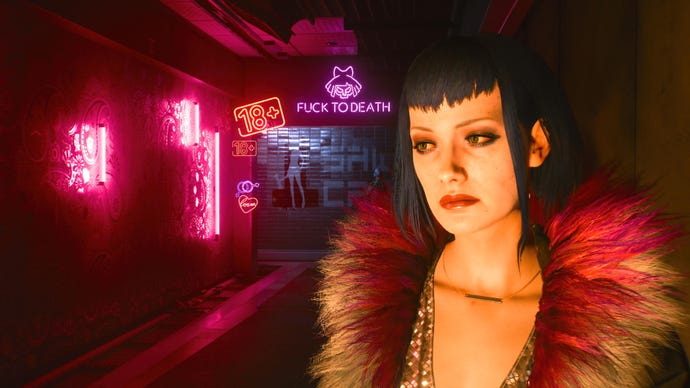Cyberpunk 2077’s attitudes towards women are more 1997 than 2077
Cyberpunk 2077’s presentation of women reminds us gaming still has blindspots for representation.
Cyberpunk 2077’s best characters are women. Panam Palmer and Judy Alvarez are head and shoulders above the rest of the cast. Rogue and Claire kick ass. The purple haired Mox and Us Cracks are the most visually interesting characters in Night City. If you just look at the big picture stuff, there is so much to celebrate about the game’s presentation of women.
The problem is, these examples are icing on a cake that’s already been burnt. And not just burnt, but full of mud and rocks and blood and scorpions. A cake that’s not just bad, it’s nasty. Not poorly made, but designed to hurt. Instead of icing on a cake, maybe the better metaphor is clay around a C4. Cyberpunk 2077 acts like it loves women, but Night City itself hates them.
In any game with a character creator, historical statistics show that in general more players will choose male, because more men play these major games more than any other gender. There are a plethora of reasons for this, but I’d like to park them and just… it’s a fact. Men do. So I always play as a woman knowing that I’m playing the game ‘wrong’. Some games actually surprise me and feel incredibly inclusive, most feature little winks or moments that suggest male is the default without it being too invasive. Cyberpunk 2077 is something else entirely. In fact, it’s the most aggressively masculine game I’ve ever played.
This is reinforced right from the start. In V and Jackie’s first playable mission together, you’re tasked with finding Sandra Dorsett; you later find her naked, almost dead, in an ice bath. In a scripted cutscene, you pull her out with her skin bluing from the cold, her nipples clearly on display as V stares into her lifeless eyes. A man in the bath with Sandra is given the dignity of underwear, but Sandra is not. While Sandra is the most unmissable dying, naked woman, she’s far from the last. Throughout Night City, we see several women dead on the floor as set decoration, often naked, as well as many strewn across ripperdoc tables with their bodies (also naked) ripped open.
This is followed by the game’s treatment of Evelyn Parker, who seems at first like she’ll be one of the game’s strong female leads. She’s cool, stylish, and confident, even if we accept the fact that we meet her at a strip club while being given a virtual naked lap dance. We then see her memories, where she’s scared around big, tough men, is literally called “fuckable meat”, and uses her wily powers of seduction to betray a man. Next time we see her, she’s naked, battered, and bloody. Next time we see her after that, she’s dead.
Then there’s the posters. Much like the mutilated women, they’re scattered around the world as a constant reminder of who Night City belongs to, and who it doesn’t. We see women shooting themselves in the head while masturbating, snakes slithering towards a woman’s naked buttocks, dogs licking beer off a woman’s naked chest, a woman spraying champagne froth suggestively down her face and chest, uncountable numbers of naked breasts, and many, many more exploitative posters.
If you’ve read this far without rushing to the comments/Twitter to berate me, you might be wondering what my point is. So it treats women badly, lots of games do. What’s your point?
Well, my point is lots of games don’t. Not any more, and not like this. Never on this scale. While women are still in the minority when it comes to playable characters, we’re seeing more major games push women to the forefront, less hypersexualisation, more agency and character development, and more nuanced storytelling in general in gaming. Even in male led games, we’re seeing a greater emphasis on emotional development, on relationships. The Kratos of 2018 is very different to the one of 2005. Arthur Morgan’s sensitivity would have been out of place in the first Red Dead Redemption.
There’s still a big “might is right” mentality in gaming, where violence is the solution to any problem, but it’s clear to see the medium has grown up a lot. I thought we’d left the “Ha! T*ts! They’re for doing sex with!” stuff back with Duke Nukem in the ‘90s.
The problem isn’t that these things exist in Cyberpunk 2077. It’s that we give them a pass to exist. Gaming has not held these attitudes for a long time, and when a game literally pastes them from wall to wall, it’s disappointing to see it lauded so uncritically. So many conversations around the game post-release revolved around “Imagine what this game would be like without the bugs?”, but unfortunately, the answer is “still one that hates women.” It’s not a bug, it’s a feature. That’s not to mention the transphobia present, the Yellow Peril tropes of the world building, or the fact the game contains an alt-right meme. This tolerance of the game’s worst aspects fosters the sort of environment for a mod to put Judy (canonically a lesbian) through conversion therapy so she’ll sleep with men. This in turn was then tolerated and often reported as a fun and kooky mod, and not as something harmful and entitled.
The vague defence offered against this has been that the game is a dystopia, but a dystopia of what? What is it trying to say? What is this misogyny supposed to comment on or satirise? What do these dead, naked, or dead and naked women add to the game’s storytelling or wider ideas? How are they offset by the likes of Panam, Judy, and Rogue?
We can’t bleat on about trying to make gaming a more diverse, welcoming environment, then celebrate the sorts of games which make the space so unwelcoming in the first place. Cyberpunk 2077 isn’t just an example of why men play AAA games more; it’s an attempt to keep it that way.












